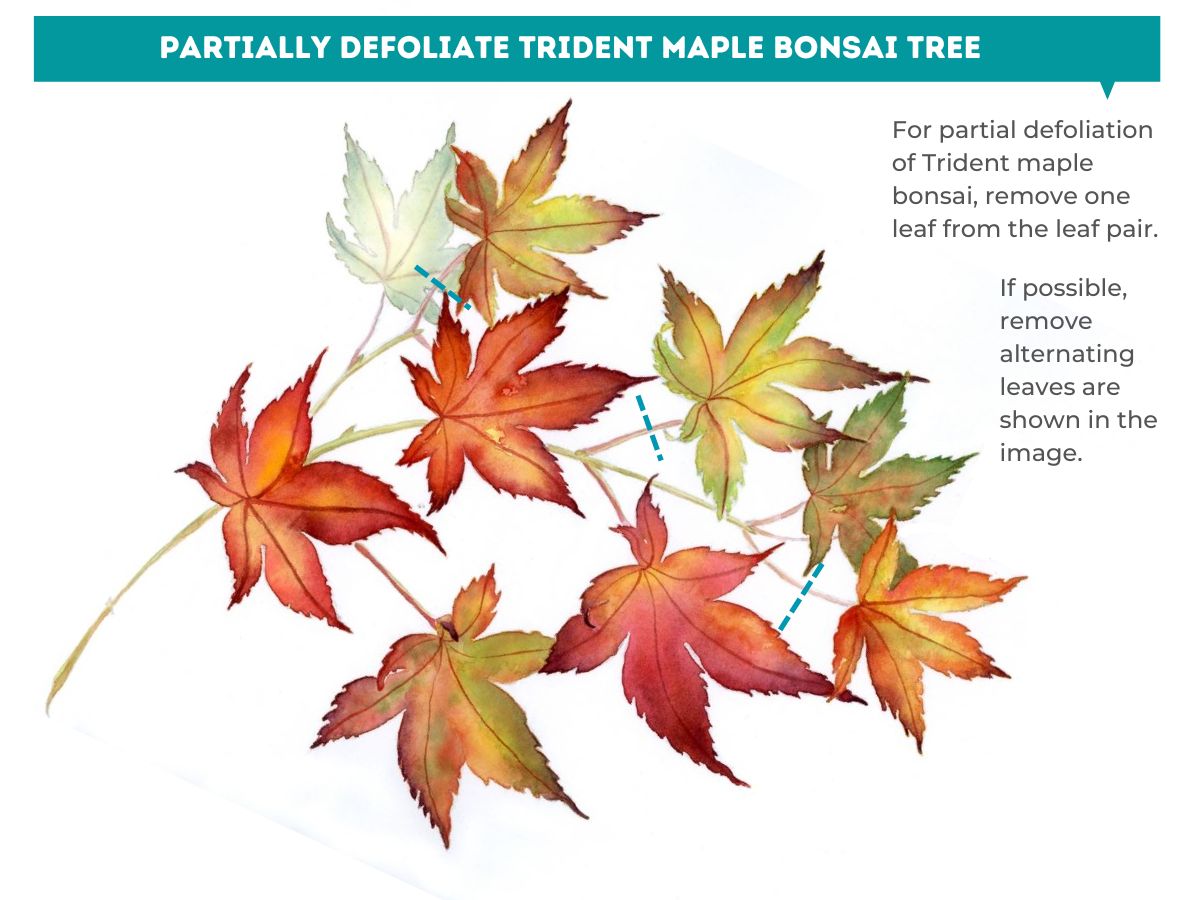If you’re a bonsai enthusiast, you’ve probably come across the term “defoliating” while researching about Trident Maple Bonsai.
Defoliating is a crucial technique in the art of bonsai that involves removing the leaves of a tree to stimulate new growth and enhance its overall aesthetics.
In this article, we’ll delve deeper into the art of defoliating Trident Maple Bonsai, discussing its importance, when to perform it, and how to do it properly. For more info on pruning, please read How to Prune a Trident Maple Bonsai.
Continue reading trident maple bonsai care for all the guidelines on how to take care of your trident maple bonsai.
The Importance of Defoliating Trident Maple Bonsai
Benefits of Defoliating Trident Maple Bonsai
Defoliating Trident Maple Bonsai offers numerous benefits.
Firstly, it promotes the growth of finer branches, as the energy that would have been used for leaf production is redirected towards creating new shoots. This leads to increased ramification and a more mature appearance.
Secondly, defoliating helps reduce leaf size. Trident Maple Bonsai typically has larger leaves, but by removing them, you encourage the growth of smaller, more proportional leaves. This enhances the overall visual balance of the bonsai and creates a more realistic representation of a mature tree.
Finally, defoliating allows you to assess the tree’s overall health by providing a clearer view of the branches and structure. This helps in identifying any potential issues and making necessary adjustments to ensure the tree’s well-being.
When to Defoliate Trident Maple Bonsai
Seasonal Timing
The timing of defoliation is crucial to ensure the best results and minimize stress on the tree.
In general, the ideal time to defoliate Trident Maple Bonsai is during the late spring or early summer when the tree is in its vigorous growth phase.
At this time, the tree has fully developed its leaves, and the new growth is beginning to harden off.
Considerations for Defoliation
Before defoliating your Trident Maple Bonsai, there are a few factors to consider.
Firstly, ensure that the tree is healthy and strong enough to withstand the stress of defoliation. If the tree is weak or recovering from previous work, it’s best to delay defoliation until it has regained its vigor.
Additionally, take into account the local climate and weather conditions. Extreme heat or drought can put additional stress on the tree, so it’s advisable to avoid defoliating during such periods.
Monitor the weather forecast and choose a time when the conditions are relatively mild and stable.
Step-by-Step Guide to Defoliating Trident Maple Bonsai
1. Prerequisites
Before you start the defoliation process, make sure you have the following prerequisites in place:
- A healthy and vigorous Trident Maple Bonsai
- Suitable weather conditions
- Necessary tools and materials
2. Tools Required
To defoliate Trident Maple Bonsai effectively, you’ll need the following tools:
- Pruning shears: Used to remove the leaves cleanly and with precision.
- Bonsai wire: Helps hold the branches in place and create desired shapes after defoliation.
- Watering can: Essential for maintaining proper hydration after defoliation.
You can also do it by hands however, using a sharp sanitized pruning shear is recommended. Continue reading about bonsai tools and their uses. Also, read how to keep you bonsai tools clean.
3. Complete Defoliation Process
Follow these steps to defoliate your Trident Maple Bonsai:
- Assess the tree’s overall health and vigor.
- Select the branches you wish to retain and wire them into the desired positions if needed.
- Carefully remove all the leaves from the selected branches using pruning shears.
- Ensure clean cuts to minimize stress on the tree.
- After defoliation, water the bonsai thoroughly to help it recover and reduce stress.
- Place the bonsai in a partially shaded area for a few days to protect it from direct sunlight and prevent excessive evaporation.
You can also carry partial defoliation of trident maple bonsai. Follow the procedure given in the image below:

Caring for Defoliated Trident Maple Bonsai
Aftercare Tips
After defoliation, it’s important to provide proper care to ensure the bonsai’s healthy recovery:
- Maintain consistent watering: Monitor the soil moisture and water the bonsai when the top layer of soil feels slightly dry. Avoid overwatering, as it can lead to root rot.
- Partial shade: Protect the defoliated bonsai from direct sunlight for a few days to prevent excessive stress on the tree.
- Fertilize appropriately: Use a balanced bonsai fertilizer to provide essential nutrients for new growth.
- Monitor for pests and diseases: Regularly inspect the bonsai for any signs of pests or diseases and take appropriate measures if necessary.
Monitoring the Recovery Process
Observe your Trident Maple Bonsai closely after defoliation to monitor its recovery.
New buds and shoots should start emerging within a few weeks. As the new growth develops, adjust the wiring and continue shaping the branches to maintain the desired form and structure.
Regularly evaluate the tree’s health and make any necessary adjustments to ensure its well-being.
Common Mistakes to Avoid
- One of the most common defoliation mistake bonsai growers (especially new growers) make is defoliating the plant without paying attention to the health of the plant. Be absolutely sure about the good health of the bonsai and make sure that the roots are not pot bound.
- Aftercare plays a crucial role in the bonsai’s recovery after defoliation. Neglecting proper watering, shading, and fertilization can impede the tree’s ability to regain its vigor and could lead to long-term health issues. Be attentive to the tree’s needs and provide the necessary care during the recovery period.
- Performing defoliation at the wrong time of the year can adversely affect the bonsai. Defoliating during periods of extreme weather conditions or when the tree is weak and vulnerable can lead to additional stress and slow down the recovery process. Follow the recommended timing guidelines mentioned earlier to ensure optimal results.
FAQs
1. Is defoliating harmful to my Trident Maple Bonsai?
Defoliating Trident Maple Bonsai, when done correctly and at the right time, is not harmful. It stimulates new growth and helps refine the tree’s appearance. However, it’s important to follow proper techniques and provide adequate aftercare to minimize stress on the bonsai.
2. Can I defoliate my trident bonsai at any time of the year?
No, defoliation should be performed during the late spring or early summer when the Trident Maple is in its active growth phase. Avoid defoliating during extreme weather conditions or when the tree is weak.
3. How often should I defoliate my Trident Maple Bonsai?
The frequency of defoliation depends on the tree’s health and growth rate. Typically, defoliation can be done once a year or every two years. Monitor the tree’s response and only defoliate when it has fully recovered from the previous defoliation.
4. Can defoliation improve the health of my bonsai?
Defoliation primarily focuses on improving the bonsai’s aesthetic appearance and ramification. While it can indirectly benefit the tree’s health by promoting new growth, other cultural practices such as proper watering, fertilization, and pest management are crucial for maintaining the bonsai’s overall health.
5. Should I defoliate all the leaves or only some?
Defoliating all the leaves is not recommended. It’s best to defoliate a portion of the leaves, leaving some foliage for photosynthesis and energy production. This approach ensures that the tree maintains its health and recovers effectively from the defoliation process.

